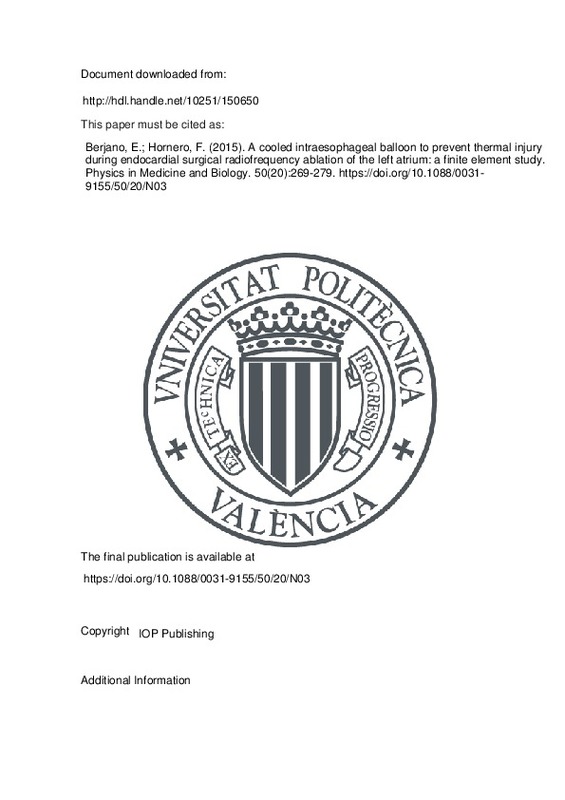Al-Zaben, A., & Chandrasekar, V. (2005). Effect of esophagus status and catheter configuration on multiple intraluminal impedance measurements. Physiological Measurement, 26(3), 229-238. doi:10.1088/0967-3334/26/3/008
Bhattacharya, A., & Mahajan, R. L. (2003). Temperature dependence of thermal conductivity of biological tissues. Physiological Measurement, 24(3), 769-783. doi:10.1088/0967-3334/24/3/312
Benussi, S., Nascimbene, S., Agricola, E., Calori, G., Calvi, S., Caldarola, A., … Alfieri, O. (2002). Surgical ablation of atrial fibrillation using the epicardial radiofrequency approach: mid-term results and risk analysis. The Annals of Thoracic Surgery, 74(4), 1050-1057. doi:10.1016/s0003-4975(02)03850-x
[+]
Al-Zaben, A., & Chandrasekar, V. (2005). Effect of esophagus status and catheter configuration on multiple intraluminal impedance measurements. Physiological Measurement, 26(3), 229-238. doi:10.1088/0967-3334/26/3/008
Bhattacharya, A., & Mahajan, R. L. (2003). Temperature dependence of thermal conductivity of biological tissues. Physiological Measurement, 24(3), 769-783. doi:10.1088/0967-3334/24/3/312
Benussi, S., Nascimbene, S., Agricola, E., Calori, G., Calvi, S., Caldarola, A., … Alfieri, O. (2002). Surgical ablation of atrial fibrillation using the epicardial radiofrequency approach: mid-term results and risk analysis. The Annals of Thoracic Surgery, 74(4), 1050-1057. doi:10.1016/s0003-4975(02)03850-x
Berjano, E. J., & Hornero, F. (2004). Thermal-Electrical Modeling for Epicardial Atrial Radiofrequency Ablation. IEEE Transactions on Biomedical Engineering, 51(8), 1348-1357. doi:10.1109/tbme.2004.827545
Berjano, E. J., & Hornero, F. (2005). What affects esophageal injury during radiofrequency ablation of the left atrium? An engineering study based on finite-element analysis. Physiological Measurement, 26(5), 837-848. doi:10.1088/0967-3334/26/5/020
Chang, I. A., & Nguyen, U. D. (2004). Thermal modeling of lesion growth with radiofrequency ablation devices. BioMedical Engineering OnLine, 3(1). doi:10.1186/1475-925x-3-27
Chiappini, B., Martìn-Suàrez, S., LoForte, A., Di Bartolomeo, R., & Marinelli, G. (2003). Surgery for atrial fibrillation using radiofrequency catheter ablation. The Journal of Thoracic and Cardiovascular Surgery, 126(6), 1788-1791. doi:10.1016/s0022-5223(03)01045-6
Doll, N., Borger, M. A., Fabricius, A., Stephan, S., Gummert, J., Mohr, F. W., … Hindricks, G. (2003). Esophageal perforation during left atrial radiofrequency ablation: Is the risk too high? The Journal of Thoracic and Cardiovascular Surgery, 125(4), 836-842. doi:10.1067/mtc.2003.165
Gabriel, C., Gabriel, S., & Corthout, E. (1996). The dielectric properties of biological tissues: I. Literature survey. Physics in Medicine and Biology, 41(11), 2231-2249. doi:10.1088/0031-9155/41/11/001
Gaynor, S. L., Diodato, M. D., Prasad, S. M., Ishii, Y., Schuessler, R. B., Bailey, M. S., … Damiano, R. J. (2004). A prospective, single-center clinical trial of a modified Cox maze procedure with bipolar radiofrequency ablation. The Journal of Thoracic and Cardiovascular Surgery, 128(4), 535-542. doi:10.1016/j.jtcvs.2004.02.044
Gillinov, A. M., Pettersson, G., & Rice, T. W. (2001). Esophageal injury during radiofrequency ablation for atrial fibrillation. The Journal of Thoracic and Cardiovascular Surgery, 122(6), 1239-1240. doi:10.1067/mtc.2001.118041
Haemmerich, D., Webster, J. G., & Mahvi, D. M. (s. f.). Thermal dose versus isotherm as lesion boundary estimator for cardiac and hepatic radio-frequency ablation. Proceedings of the 25th Annual International Conference of the IEEE Engineering in Medicine and Biology Society (IEEE Cat. No.03CH37439). doi:10.1109/iembs.2003.1279532
YEN HO, S., SANCHEZ-QUINTANA, D., CABRERA, J. A., & ANDERSON, R. H. (1999). Anatomy of the Left Atrium:. Journal of Cardiovascular Electrophysiology, 10(11), 1525-1533. doi:10.1111/j.1540-8167.1999.tb00211.x
Hornero, F., Rodriguez, I., Bueno, M., Buendia, J., Dalmau, M. J., Canovas, S., … Montero, J. A. (2004). Surgical Ablation of Permanent Atrial Fibrillation by Means of Maze Radiofrequency:. Mid-Term Results. Journal of Cardiac Surgery, 19(5), 383-388. doi:10.1111/j.0886-0440.2004.04077.x
Jain, M. K., & Wolf, P. D. (1999). Temperature-controlled and constant-power radio-frequency ablation: what affects lesion growth? IEEE Transactions on Biomedical Engineering, 46(12), 1405-1412. doi:10.1109/10.804568
Lemola, K., Sneider, M., Desjardins, B., Case, I., Han, J., Good, E., … Oral, H. (2004). Computed Tomographic Analysis of the Anatomy of the Left Atrium and the Esophagus. Circulation, 110(24), 3655-3660. doi:10.1161/01.cir.0000149714.31471.fd
Nath, S., Lynch, C., Whayne, J. G., & Haines, D. E. (1993). Cellular electrophysiological effects of hyperthermia on isolated guinea pig papillary muscle. Implications for catheter ablation. Circulation, 88(4), 1826-1831. doi:10.1161/01.cir.88.4.1826
Pappone, C., Oral, H., Santinelli, V., Vicedomini, G., Lang, C. C., Manguso, F., … Morady, F. (2004). Atrio-Esophageal Fistula as a Complication of Percutaneous Transcatheter Ablation of Atrial Fibrillation. Circulation, 109(22), 2724-2726. doi:10.1161/01.cir.0000131866.44650.46
Sonmez, B., Demirsoy, E., Yagan, N., Unal, M., Arbatli, H., Sener, D., … Ilkova, F. (2003). A fatal complication due to radiofrequency ablation for atrial fibrillation: atrio-esophageal fistula. The Annals of Thoracic Surgery, 76(1), 281-283. doi:10.1016/s0003-4975(03)00006-7
[-]







![[Cerrado]](/themes/UPV/images/candado.png)


